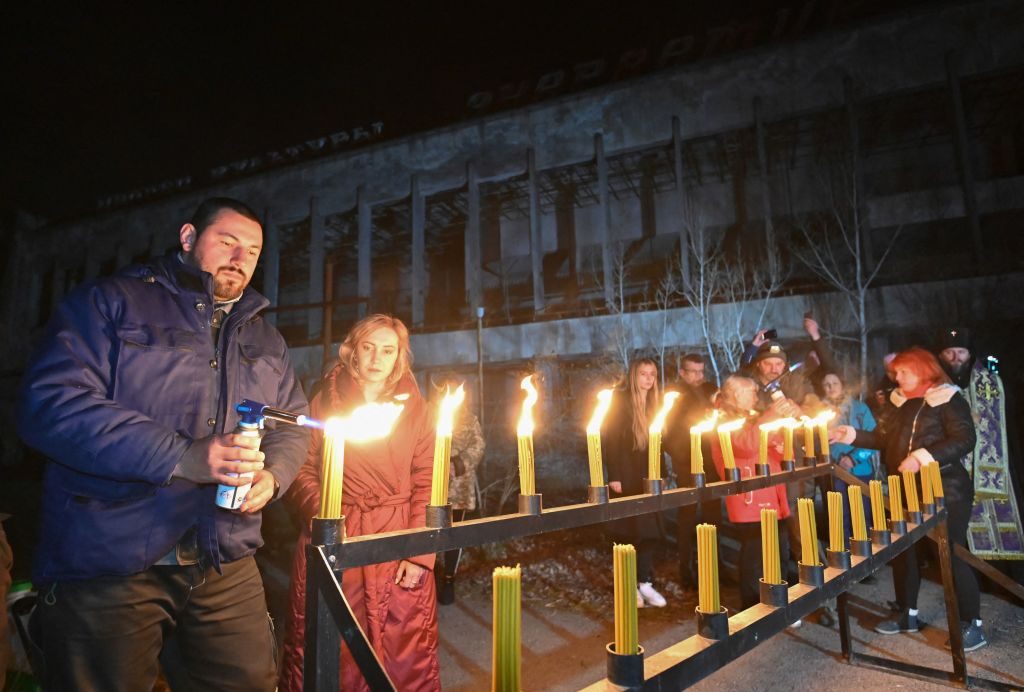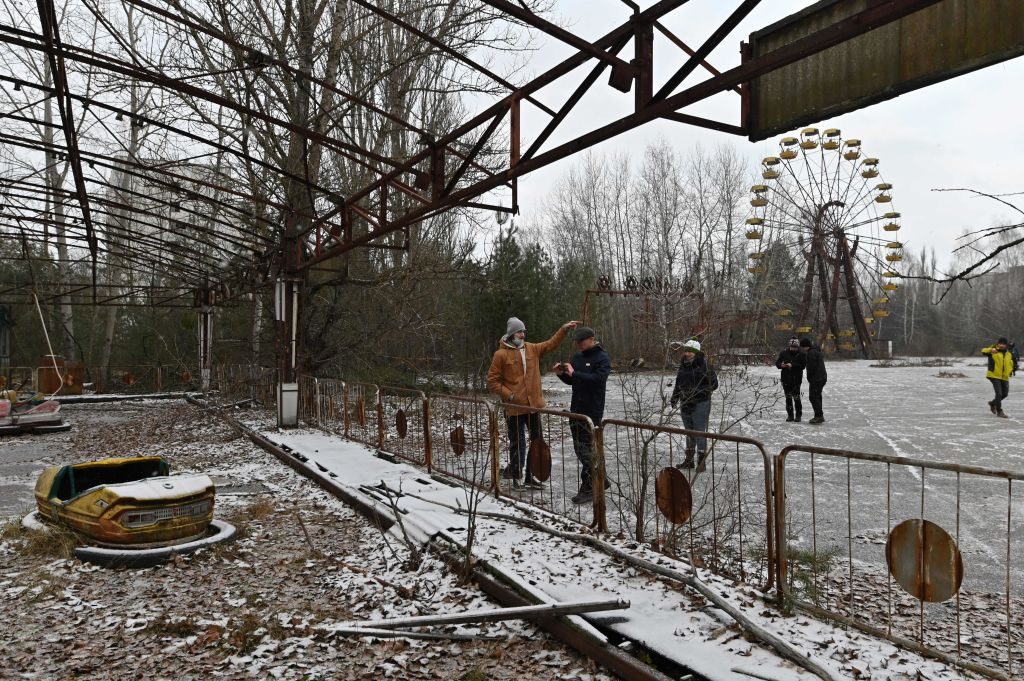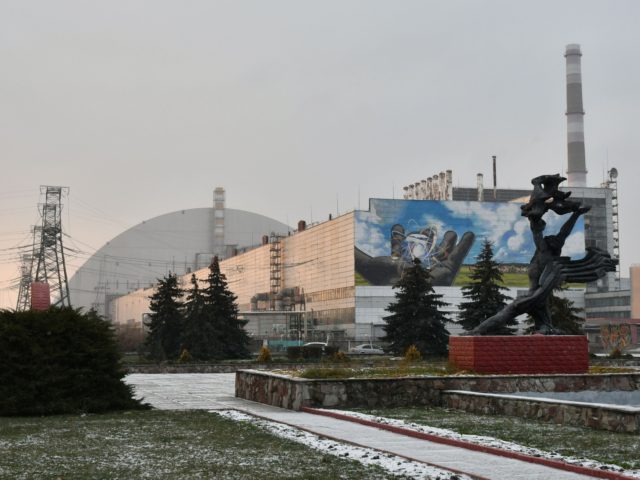Ukraine marked the 36th anniversary of the Chernobyl nuclear disaster on Tuesday with a visit to the site by the head of the International Atomic Energy Agency (IAEA) to inspect potential damage caused by the brief Russian takeover of the former plant in February and March.
While Ukraine typically observes the anniversary with somber remembrace ceremonies in Kyiv and the Chernobyl Exclusion Zone, President Volodymyr Zelensky does not appear to have attended any such events by evening on Tuesday, instead managing his country’s ongoing response to Russia’s full-scale invasion that began in February. Last year, for the 25th anniversary of the occasion, Zelensky visited the exclusion zone, promising a post-nuclear “renaissance” fueled by tourism and development for the area. Ukraine filmed the music video for its 2021 Eurovision Song Contest entry on site at the exclusion zone,
The Russian government under Vladimir Putin invaded and colonized part of Ukraine, the Crimea region, in 2014, and has been supporting pro-Russian separatists in the eastern Donbas region since then. In February, however, Putin announced a new military operation to “de-Nazify” Ukraine that swept far beyond Donbas into the Kyiv metropolitan area, the southern port city of Mariupol, and several other urban population centers.
On February 24, Russian forces seized the site of the Chernobyl Nuclear Power Plant, prompting fears that military activity at the site would cause another nuclear disaster.
Zelensky tweeted Thursday morning that Russian forces are trying to seize the Chernobyl Nuclear Power Plant in northern Ukraine. https://t.co/YgknnaTUUD
— Breitbart News (@BreitbartNews) February 24, 2022
On April 26, 1986, deliberate government mismanagement caused a nuclear meltdown at the Chernobyl Nuclear Power Plant, then a Soviet property. The incident is considered the worst nuclear disaster in history, rendering the surrounding area uninhabitable and forcing the evacuation of the neighboring town of Pripyat, home to 50,000 people, and surrounding villages in what is now Ukraine and Belarus. The Soviet Union deliberately refused to admit the scale of the disaster for years and refused to notify the rest of the world in the immediate aftermath of the meltdown. It finally asked for international assistance in 1990. The residents evacuated would later state they had no idea the government was permanently evacuating them from their homes and packed for a short trip.
Scientists estimate that the meltdown sent materials about 97 percent more radioactive than the product of the Hiroshima nuclear bombing into the air. The Chernobyl Exclusion Zone is still considered uninhabitable, but Kyiv had begun to increasingly allowed tour groups to visit the site prior to the Russian invasion of the area. An estimated 8.4 million people were exposed to high levels of radiation as a result of the preventable disaster.
“The [Chernobyl nuclear] disaster is the most horrifying technology catastrophe of the 20th century,” the Ukrainian Ministry of Foreign Affairs said in a statement on social media on Tuesday. “Today’s Russia’s [sic] invasion of Ukraine put the world [sic] at risk of nuclear disaster.”
The #Chornobyl nuclear disaster is the most horrifying technology catastrophe of the 20th century. Today's #Russia's invasion of #Ukraine put the world at risk of nuclear disaster.
We cannot allow the #Chornobyl catastrophe to repeat.#ArmUkraineNow pic.twitter.com/0TE5zz1dfo
— MFA of Ukraine 🇺 (@MFA_Ukraine) April 26, 2022
The IAEA announced on Monday that its director-general, Rafael Mariano Grossi, would be on site on Tuesday at the Chernobyl power plant for its “first full-fledged assistance mission of safety, security and safeguards experts to the country [Ukraine].”
“The team will arrive at the Chornobyl Nuclear Power Plant (NPP) on Tuesday to deliver equipment, conduct radiological assessments and restore safeguards monitoring systems,” the IAEA said. The global nuclear agency stated that Grossi would not be able to update on what he found at the site until Thursday, when he will be out of the exclusion zone and in Vienna, Austria.
Before leaving, however, the IAEA quoted Grossi as saying on Monday, “In the case of Ukraine, we are working within, and to a great extent thanks to, the existing framework of norms and procedures through the IAEA’s Incident and Emergency Centre, including through the Agency’s Response and Assistance Network (RANET), which has been operating for a long time.”
Last week, announcing the visit today, Grossi emphasized that having the top administrators of the IAEA at the Chernobyl plant amid the ongoing war was “of paramount importance for our activities to support Ukraine as it seeks to restore regulatory control of the plant and ensure its safe and secure operation” and promised to visit other nuclear sites in the country allegedly under Russian threat.
The Ukrainian government has expressed particular concern for the Zaporizhia Nuclear Power Plant, which it has claimed to be under Russian attack in the past. In March, Ukrainian authorities claimed that the Russians had attacked the plant and threatened its nuclear supply, though later reports revealed a fire at a facility in the expansive complex far from the reactors that workers put out without major incident.
On Tuesday, the state news outlet Ukrinform accused Russia of flying cruise missiles over the Zaporizhia plant, proclaiming, “Russia’s nuclear terrorism is on the rise, and the threat is becoming more apparent. Energoatom stressed that Russia exposed the whole world to the danger of a new nuclear catastrophe 36 years into the Chornobyl tragedy.”

File/People light candles on the central square of the ghost town of Pripyat near the Chernobyl Nuclear Power Plant on early April 26, 2021, to commemorate the 35th anniversary of the Chernobyl nuclear disaster. (GENYA SAVILOV/AFP via Getty Images)
The Russian government has denied all accusations of threatening nuclear sites and repeatedly accused Ukraine of plotting, with American help, “false flag” biological and chemical attacks to blame on Moscow.
At the Chernobyl site, Ukraine regained control from Russian fighters on April 19 and its nuclear scientists have been working to evaluate any damage to safety equipment and protocol on the site.
“Three weeks after the departure of Russian forces on March 31, the situation around the facility is still complicated, with some areas left mined by Moscow soldiers,” the French newspaper Le Monde reported from the site on Monday. The Russians kept Ukrainian scientists on site to continue “to ensure the facility’s safety under extremely difficult conditions, working continuously without being able to return home,” the newspaper noted. Some of those workers spoke to Le Monde, describing working-class Russian soldiers looting everything they could from the site.
“The Russian soldiers, who come from poor rural areas, took everything they could get their hands on, computers, printers, electrical appliances, or even spoons or forks … Everything they could get their hands on,” Petro Kotin, the head of the Ukrainian state-owned nuclear energy company Energoatom, told Le Monde.

File/Visitors walk in an abandoned amusement park in the ghost town of Pripyat, not far from Chernobyl nuclear power plant, on December 8, 2020. (GENYA SAVILOV/AFP via Getty Images)
During tourist visits to Chernobyl, tour groups strictly prohibit visitors from taking anything off-site, even seemingly innocuous items like rocks or debris, because they may be highly radioactive and pose a danger to those exposed to it without proper protective equipment. Officials will confiscate even personal items from tourists if placed on the ground and thus exposed to radioactive materials, even if brought in from outside.
“I look forward to being able to talk to the staff and to express my deep gratitude for everything they have achieved during such immensely stressful and challenging conditions,” Grossi, the IAEA chief, said on Monday, referring to workers at the Chernobyl plant. “They have been through more than we can imagine, and they deserve our full respect and admiration for preserving the safety and security of the site despite the dire situation.”

COMMENTS
Please let us know if you're having issues with commenting.